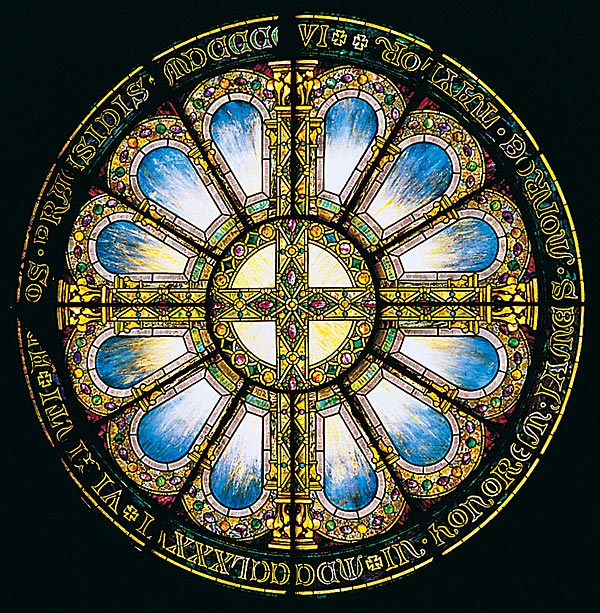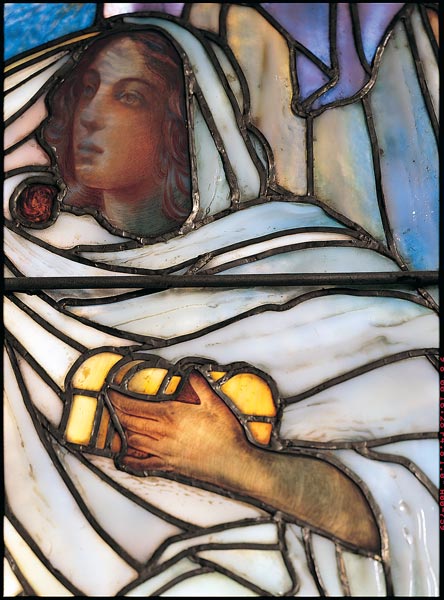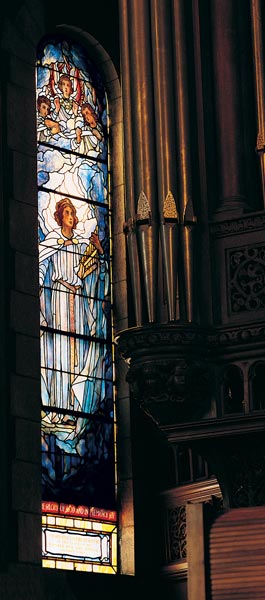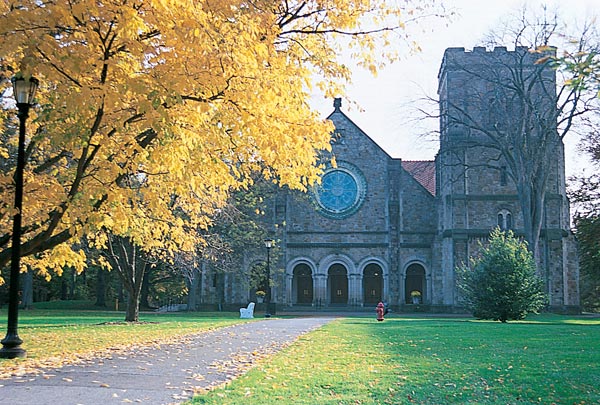Campus Angels: Vassar's Chapel
The Vassar College Chapel, a handsome Norman-revival structure of granite and sandstone, has graced the lawn inside of Main Gate for almost a century. Although often taken for granted as one of the most beautiful buildings on campus, the structure — with its unique art and architecture, including gorgeous stained-glass windows — bears closer scrutiny.
The chapel, which is currently undergoing extensive renovation (this article was written in 2002, see text at the end of the article), was a joint gift of alumnae Mary Shaw Thompson 1877 and Mary Morris Pratt 1880, who gave almost $200,000 to memorialize Vassar graduates. The cornerstone was laid October 4, 1902, and the building was dedicated November 4, 1904. Its open interior, with a ceiling supported by wooden beams, served the dual purpose of assembly hall and religious space. (While the former role was more central to the life of the college before the student body outgrew its seating capacity, convocations and special lectures and performances still draw large crowds to the chapel.)
The building owes its architectural distinction to the Boston firm of Shepley, Rutan & Coolidge. (H.H. Richardson, who designed the Trinity Church in Boston’s Copley Square and was the most famous interpreter of Romanesque architecture in America, belonged to this firm.) Part of the pleasure of exploring the chapel comes from examining details such as the ornamental brickwork and applied reliefs, and the plethora of carved stone capitals.
Inside, the stained-glass windows are just as breathtaking. They are the work of Louis Comfort Tiffany, John La Farge, and Robert Leftwich Dodge — three important New York craftsmen who helped develop techniques that enabled glass to achieve entirely new effects of light, color, and design. The Vassar windows demonstrate these technical achievements with their variegated color patterns, textured surfaces, plating of several layers of glass, and delicate enamel paints.

The Louis Comfort Tiffany Rose Window was installed in 1906. The 12-foot-diameter window rests above the front entrance to the chapel.
One can admire the planned interaction of art and architecture, as when outside porch arcades serve to frame the stained-glass windows and allow natural light to shine through. Both Dodge and Tiffany capitalized on the morning light from the east, using it to work with the idea of the imagery. As John Hupcey, an IBM engineer and author of a descriptive leaflet of the Vassar Chapel (1983), noted, in one Dodge window, figures backed by a rendition of an early morning sunrise remain in dark shadows until light shines on or through the window, bringing to life the words on the glass: “Until the day break, and the shadows flee away” (Solomon 2:17). Tiffany’s Angel of Resurrection in another window takes on heightened meaning during an actual sunrise.
All 10 of the Vassar chapel windows were created between 1905 and 1909. With the exception of the great Tiffany rose window above the entrance — given by the trustees in 1906 to commemorate former college president James Monroe Taylor — all of the windows are memorials to Vassar alumnae, and each reveals something of the history of the college.

Angels form part of the thematic unity of the Vassar Chapel. They appear as standing figures in the west wall, in romantic landscape views in the east wall, and again as gilded half-figures terminating the ceiling beams. In this memorial context, angels read as messengers of hope for the resurrection of the dead, and more specifically, as hope for the resurrection of deceased Vassar alumnae. This aspect of the chapel decoration indicates religious beliefs held by many Vassar alumnae in the early years of the 20th century.
For example, the Saint Cecilia window to the left of the organ, executed by Dodge in 1909, was given by Adaline Jenckes 1887 in memory of Charlotte Elizabeth Finch 1872. Miss Finch was the organist and teacher of music at Vassar until her death in 1885. She was also involved with the Cecilia Society, whose members sang together and gave a concert once a year for invited guests. Clearly an association between the alumna/organist and Saint Cecilia, patron saint of music and particularly the organ, was intended. Also, it was traditional at this time to combine images of saints and actual people in church decor — and, in fact, the face and hair of the Saint Cecilia bears some resemblance to that of Miss Finch.

There is the real possibility that layered intentions in the chapel imagery have been lost over time. For example, Dodge’s companion piece to the Saint Cecilia window, to the right of the organ, invites more investigation. What did the Latin inscription, “Bis viventes. Bis laudantes. Pro mortuis a sodalibus dilectis,” below the standing angel connote to the donors, the class of 1877? These Latin words, translated in the chapel’s leaflet as “Living twice. Praising twice. For the dead from the chosen members,” no doubt resonated with Vassar alumnae 100 years ago in ways they would not today.
Robert Leftwich Dodge created the pair of windows that stand on either side of the organ. Pictured is the Saint Cecilia window in memory of Miss Charlotte Finch, class of 1872.
Whatever the intended messages in its century-old imagery, the chapel remains a repository of memories for generations of Vassar graduates — both for its striking appearance and for what has taken place inside. Next time you’re on campus, you might pause a while in this historic building. Chances are, you may recall marching down the aisle for college assemblies to the accompaniment of booming organ music, listening to Eleanor Roosevelt speak of the need for a United Nations, or hearing pianist John Cage give a concert. And if you take a few more moments to take in the remarkable detail of the chapel’s art and architecture, perhaps you’ll come away with even more memories.
—Bernice L. Thomas ’49
Bernice L. Thomas ’49 is an independent scholar with an M.A. and Ph.D. in art history from Boston University. Her publications include America’s 5 & 10 Cent Stores: The Kress Legacy (1997) and a recent book entitled The Stamp of FDR: New Deal Post Offices in the Mid-Hudson Valley. She currently lives in Poughkeepsie.
Chapel Construction Update

In the summer of 2002, a multi-year restoration project began on the Vassar College Chapel. Repairs and restoration to the west façade stone work and the west transcept leaded-glass windows are complete. Although the chapel remains open for use by the Vassar community, further restoration is required in the coming years. The college is making plans to continue the work next summer, focusing on the north façade and the Tiffany Rose window above the chapel’s entrance. This critical preservation work will move forward as funds become available.
